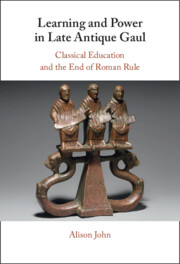Refine search
Actions for selected content:
172 results
Chapter 1 - Classical Education in the Late Roman World
-
- Book:
- Learning and Power in Late Antique Gaul
- Published online:
- 22 December 2025
- Print publication:
- 22 January 2026, pp 23-49
-
- Chapter
- Export citation
Fifth Collection
- from Letters for the Advancement of Humanity
-
- Book:
- Johann Gottfried Herder: Letters for the Advancement of Humanity
- Published online:
- 13 December 2025
- Print publication:
- 22 January 2026, pp 207-266
-
- Chapter
- Export citation
Chapter 3 - The Relationship between Education and Power
-
- Book:
- Learning and Power in Late Antique Gaul
- Published online:
- 22 December 2025
- Print publication:
- 22 January 2026, pp 90-131
-
- Chapter
- Export citation
Introduction
-
- Book:
- Learning and Power in Late Antique Gaul
- Published online:
- 22 December 2025
- Print publication:
- 22 January 2026, pp 1-22
-
- Chapter
- Export citation

Learning and Power in Late Antique Gaul
- Classical Education and the End of Roman Rule
-
- Published online:
- 22 December 2025
- Print publication:
- 22 January 2026
Chapter 3 - Families at play
-
- Book:
- Play in the Early Years
- Published online:
- 12 December 2025
- Print publication:
- 11 December 2025, pp 44-58
-
- Chapter
- Export citation
Chapter 8 - Play in the curriculum
-
- Book:
- Play in the Early Years
- Published online:
- 12 December 2025
- Print publication:
- 11 December 2025, pp 155-177
-
- Chapter
- Export citation
4 - Evidence on Church Democratic Activism in Africa
- from Part II - Testing the Main Hypotheses
-
- Book:
- Faith in Democracy
- Published online:
- 23 October 2025
- Print publication:
- 06 November 2025, pp 73-99
-
- Chapter
- Export citation
3 - The Politics of Church Education in Sub-Saharan Africa
- from Part I - Theory
-
- Book:
- Faith in Democracy
- Published online:
- 23 October 2025
- Print publication:
- 06 November 2025, pp 46-70
-
- Chapter
- Export citation
7 - Latin in the Early History of English
- from Part II - Contact and External Influences
-
-
- Book:
- The New Cambridge History of the English Language
- Published online:
- 30 October 2025
- Print publication:
- 30 October 2025, pp 193-218
-
- Chapter
- Export citation
Compulsory curricula and human rights: a revised framework for balancing competing interests
-
- Journal:
- Legal Studies , FirstView
- Published online by Cambridge University Press:
- 23 October 2025, pp. 1-18
-
- Article
-
- You have access
- Open access
- HTML
- Export citation
Chapter 7 - Let the Young Be Your Guide
- from Part II - Case Studies
-
- Book:
- Making Meaning of Justice and Peace
- Published online:
- 06 December 2025
- Print publication:
- 25 September 2025, pp 118-142
-
- Chapter
- Export citation
Revisiting 15 000 hours: towards sustainable school systems for mental health, well-being and learning
-
- Journal:
- BJPsych Open / Volume 11 / Issue 4 / July 2025
- Published online by Cambridge University Press:
- 21 July 2025, e157
-
- Article
-
- You have access
- Open access
- HTML
- Export citation
Emergency Preparedness and Factors Influencing Decision-Making in a Sample of Public K–12 Schools During the COVID-19 Pandemic: A Mixed Methods Study
-
- Journal:
- Disaster Medicine and Public Health Preparedness / Volume 19 / 2025
- Published online by Cambridge University Press:
- 17 July 2025, e194
-
- Article
- Export citation
19 - Local Government Law for the 100-Year Life
- from Part IV - The 100-Year Life and Our Broader Environment
-
-
- Book:
- Law and the 100-Year Life
- Published online:
- 13 May 2025
- Print publication:
- 29 May 2025, pp 258-270
-
- Chapter
-
- You have access
- Open access
- HTML
- Export citation
Efficacy of a school-based mental health intervention among Zambian youth: a cluster-randomized controlled trial
-
- Journal:
- Cambridge Prisms: Global Mental Health / Volume 12 / 2025
- Published online by Cambridge University Press:
- 31 March 2025, e43
-
- Article
-
- You have access
- Open access
- HTML
- Export citation
19 - School and youth health nursing
- from Part IV - Community and primary health care roles
-
-
- Book:
- An Introduction to Community and Primary Health Care
- Published online:
- 27 March 2025
- Print publication:
- 20 March 2025, pp 292-306
-
- Chapter
- Export citation
8 - Comprehensive Deterrence Theory: Policy Implications
-
- Book:
- Comprehensive Deterrence Theory
- Published online:
- 06 March 2025
- Print publication:
- 13 March 2025, pp 199-226
-
- Chapter
- Export citation
3 - Chronicles from the Coast
-
- Book:
- The Water Diaries
- Published online:
- 06 February 2025
- Print publication:
- 13 February 2025, pp 36-56
-
- Chapter
-
- You have access
- Open access
- HTML
- Export citation
6 - Advocacy and Activism
- from Part II - Activism in the Lecture Hall and the School System
-
-
- Book:
- Language Activism
- Published online:
- 31 May 2025
- Print publication:
- 06 February 2025, pp 75-92
-
- Chapter
- Export citation
